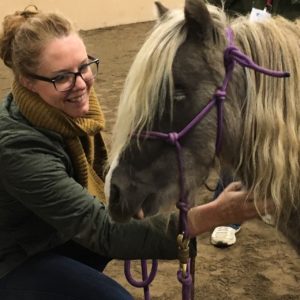 The activity was called “First Impressions.” Nine of us entered the large indoor arena, pens and notebooks in hand, with instructions from our trainers to individually choose, out of the three horses in the arena with us, one horse we would want to work with and one horse we would not want to work with. We had ten minutes to observe the horses who were in the arena with us, and then we would debrief as a group afterwards to discuss our choices. Since my background is in corporate workplace environments, I created the context of building a team – which horse would I hire and which one would I not hire?
The activity was called “First Impressions.” Nine of us entered the large indoor arena, pens and notebooks in hand, with instructions from our trainers to individually choose, out of the three horses in the arena with us, one horse we would want to work with and one horse we would not want to work with. We had ten minutes to observe the horses who were in the arena with us, and then we would debrief as a group afterwards to discuss our choices. Since my background is in corporate workplace environments, I created the context of building a team – which horse would I hire and which one would I not hire?
Of the three horses, two were full size, and one was a miniature. For some perspective, miniatures are about 1/5 the size of an average horse. The first two, Cutter and Apache (both full size), entered the arena, greeting us participants and then heading off to do their own thing. Enter Jolly. Shortly after his arrival in the arena, Jolly reared up on his back legs and whinnied loudly, making his presence known to the group. He then proceeded over to the larger horses and started nipping at their hind legs, apparently not having received the memo that he was substantially smaller than his equine counterparts. This behavior continued, and as it did I was scribbling comments in my notebook like “no boundaries,” “emotionally immature,” “bully” and “disruptive.” This was a horse that I would definitely NOT hire.
At one point during this display of unacceptable workplace behavior, Apache came back over to see me for a second time. As he approached me, Jolly came up from behind him and I knew what he was going to do. I did not want to be in the middle of their squabble, and I also wanted to send Jolly a clear message that I did not welcome his behavior anywhere near me. I waved my arms in big, sweeping motions, not saying a word but letting my body language do the talking. He turned and headed in another direction. Mission accomplished!
After our ten minutes were up, we went back into the conference room to debrief. Eight out of nine of us agreed that Jolly was not the horse (or person) we’d want to work with. After going around the table and discussing the “whys,” our trainers asked the barn owner to tell us a little about her horses and their individual personalities, since she knows them best. What we learned about Jolly is that he is blind. I would have loved to see our collective jaws drop when she shared this little golden nugget of information. Jolly, as the weakest member of the herd, was making himself known in a loud manner because he is very aware of his weakness and is constantly vying for pecking order within the herd. Therefore, he overcompensates by acting out in all the ways that he did for those ten minutes.
And then it dawned on me. How could he have turned away from me when I was waving my arms if he couldn’t see me? I was blown away. It got me to thinking about the power of intention, and how he picked up on my energy telling him to take a hike. And if that’s a possibility, then what energy do we humans express to each other without even talking to one another? Makes me think twice about how I carry myself into my next meeting.
Now, we can debate whether his limited sight was a justification for poor behavior in the “workplace.” However, I judged Jolly. I did not necessarily have all the information that I needed to make a hiring decision, I only saw a glimpse of who he was during those ten minutes. That’s what first impressions are all about, right? There’s a difference between judgement and discernment, however. I did not need to judge Jolly, I needed to discern if he would be a valuable and contributing member of my team. Based on what he showed me during his “interview,” I may likely make the same choice today. The other two horses exhibited the characteristics that I would want to be a part of my team.
But what if Jolly already was a member of my team? What if he was a coworker that demonstrated some (or all) of those behaviors and I had no choice but to work with him? Going one level deeper to understand his motivations, even if the behaviors were still frustrating to manage, would introduce a level of empathy and understanding that I otherwise wouldn’t have had. And maybe that would make all the difference in a challenging workplace dynamic.
Later that day, I went to visit Jolly in his stall. He was calm, friendly and affectionate.
Equine Assisted Learning (EAL) is an experiential learning method that helps people learn about themselves and others through a series of activities on the ground with horses. Recently, I was a participant in an EAL workshop as part of my training to become an EAL facilitator. Little did I know that during the course of the week-long training, I’d have a few “breakthrough” moments of my own.
-Amy Hill, Teams InBalance Director & Facilitator
